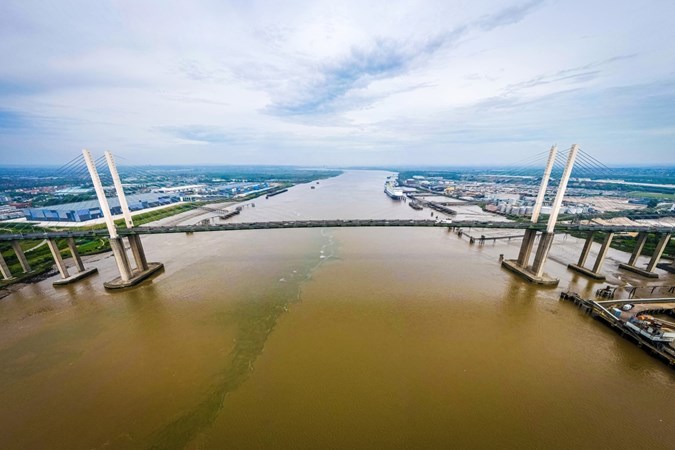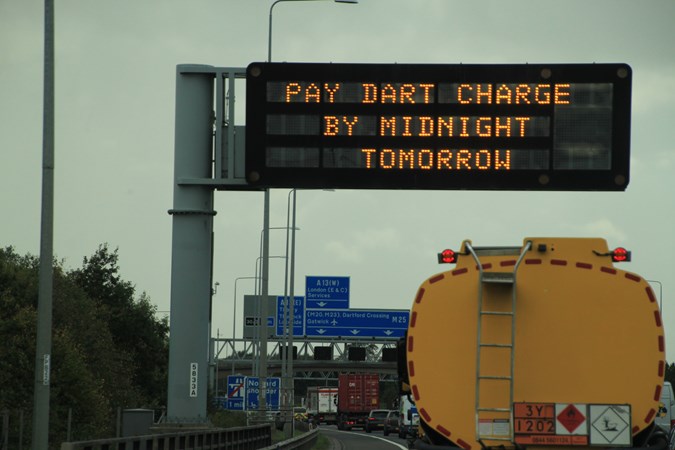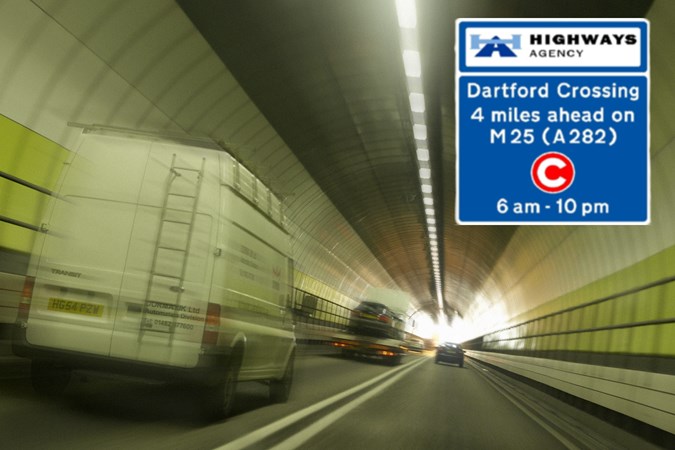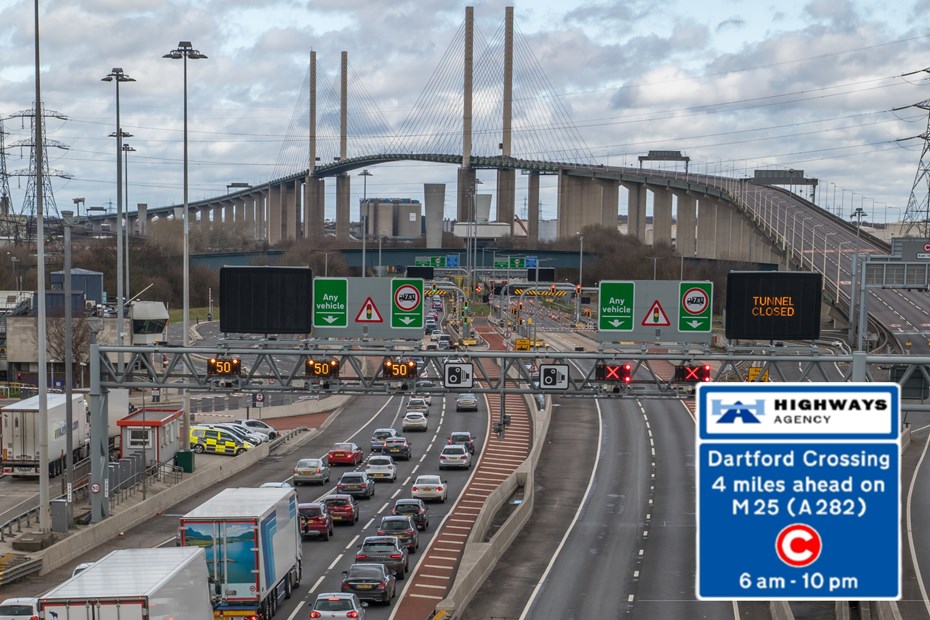The Dartford Crossing – the stretch of the M25 that crosses the River Thames between Dartford and Thurrock – is one of the UK’s busiest roads. But with no toll booths and a completely automated charging system, it can catch out even regular users – ask me how I know. If you’ve just crossed it and aren’t sure whether you need to pay – or how – our guide has you covered.
Instead of paying at the barrier, the Dartford Crossing uses automatic number plate recognition (ANPR), meaning you’ll need to pay the Dart Charge online or by phone. And here’s where many drivers get caught out: you only have until midnight the following day to pay. Miss the deadline and you could face a fine of up to £105, turning a short trip into an expensive mistake.
Whether you’re a first-time user, an occasional traveller, or someone who’s just realised they’ve crossed without paying, we’ll explain how the Dart Charge works, how much it costs, and how to pay quickly and easily. We’ve also included details on fines, appeals, and discounts for local residents – so you can get back on the road with confidence.

What is the Dartford Crossing?
The Dartford Crossing is a vital part of the M25 motorway, linking Kent and Essex via two tunnels (for southbound traffic) and the Queen Elizabeth II Bridge (used for northbound travel). It’s been automated since 2014 – meaning no toll booths and no cash transactions – and it’s a whole lot less congested these days. But it’s not exactly traffic issue-free.
That convenience comes with a catch: you must pay online or by phone, and you only have until midnight the day after your journey to do it. Miss that window, and you could be looking at a fine. If you’re new to UK toll roads network or planning a longer journey, it’s worth reading our full guide to UK toll charges for the bigger picture.
Ways to pay the Dart Charge
If you’re only using the Dartford Crossing occasionally, the most straightforward option is to make a one-off payment online via the official gov.uk Dart Charge page. You’ll need your vehicle’s registration number, the date and time of travel, and a debit or credit card. Alternatively, you can pay by calling 0300 300 0120, although wait times can be long.
For those who like to plan ahead, it’s also possible to pay in advance – up to a year ahead, in fact – which is useful if you’re preparing for a holiday or regular trips across the Thames, and you don’t change your cars regularly.
Frequent users, however, will benefit most from setting up a Dart Charge account. This allows the system to automatically deduct the fee whenever you use the crossing, saving you time and significantly reducing the risk of forgetting. There’s also a financial benefit: account holders pay £2.00 per crossing instead of the standard £2.50 for cars. You can top up your balance online and manage your details quickly online.
We cover similar setups, including how to pay for the M6 Toll, in our other guides to UK road charges.
Dart Charge costs
How much you pay to use the Dartford Crossing depends on the type of vehicle you’re driving and whether you’ve registered for a Dart Charge account. For most drivers in cars, camper vans or minibuses, the standard cost is £2.50 per crossing. However, if you set up an account, you’ll only pay £2.00 – a worthwhile saving if you use the route regularly.
The costs increase for larger vehicles. Two-axle goods vehicles, such as medium-sized vans or smaller lorries, are charged £3.00 per crossing, with a reduced rate of £2.63 for account holders. The biggest charges apply to heavy goods vehicles with multiple axles – these pay £6.00 each way, or £5.19 with a Dart Charge account. Motorcyclists get the best deal of all: they can use the crossing free of charge at any time.
There’s also a useful tip for early risers and night-time travellers: the Dartford Crossing is completely free to use between 10pm and 6am. So if your journey falls within those hours, no payment is required and there’s no need to log it online. For everyone else, it pays to be prepared – and potentially to register for an account that takes the hassle out of repeat payments.

Local resident discount
Drivers who live within the Dartford or Thurrock council boundaries can benefit from a local resident discount. For an annual fee of £10, eligible residents can enjoy unlimited crossings by car or motorcycle. To apply, you’ll need to provide proof of residency and register via the Dart Charge system. It’s a particularly good deal if you use the crossing regularly as part of your daily commute.
What happens if you don’t pay the Dart Charge?
If you fail to pay the Dart Charge by midnight the day after your crossing, a Penalty Charge Notice (PCN) will be issued to the registered keeper of the vehicle. The fine starts at £70 but is reduced to £35 if paid within 14 days. If you ignore it altogether, the penalty increases to £105 and can lead to enforcement action through debt collection or the courts. For something that costs as little as £2, it’s not worth the risk.
Don’t panic though, if you do cross and forget to pay – if it’s the first time, you’re likely to be liable just to pay the standard crossing fee. If you regularly drive in London, you’ll find the system is not too different from the London Congestion Charge, which also uses automatic cameras and strict penalties.
How to appeal a Dart Charge fine
If you’ve received a fine and believe it was issued in error, you do have the right to appeal. This might apply if you weren’t the driver at the time, have sold the vehicle, or if there was a technical error with the number plate recognition system. To appeal, you’ll need to log into your Dart Charge account or follow the guidance included with your PCN.
Just be aware that the penalty clock doesn’t stop ticking once you submit an appeal, so it’s wise to act fast and keep a record of any correspondence. Delaying action could mean a higher fine or enforcement action, even if the appeal is successful later on.
Conclusion
The Dartford Crossing might look like just another stretch of motorway, but it’s one with a price. It’s surprisingly easy to forget the Dart Charge until a fine lands on your doormat. But once you understand how the system works, staying on top of it is straightforward.
For regular users, setting up a Dart Charge account is a no-brainer. It’s faster, cheaper, and removes the risk of accidental non-payment. Occasional drivers can still pay as they go – just remember the midnight deadline and keep your vehicle registration handy. And if you’re lucky enough to travel overnight, the crossing won’t cost you a penny.
Still planning your journey or looking to brush up on tolls, traffic rules or driving tips? Catch up on all our driving advice for more practical help.

-
Is the Dartford Crossing free now?
No, the Dartford Crossing is not entirely free, despite the original build costs having been long since paid off. Charges apply between 6.00am and 10.00pm, seven days a week, including weekends and bank holidays. The only exception is the overnight period between 10.00pm and 6.00am, when all vehicles can use the crossing without paying the Dart Charge.
This free period is useful for night-time drivers and long-haul journeys, but it’s easy to get caught out if you’re travelling just before or after the cut-off. If you use the crossing at, say, 6:05am, you will still need to pay the charge. Always check the time of your crossing to avoid a surprise fine. -
How do I know if I used the Dartford Crossing?
If you travelled on the M25 between Junction 31 (Thurrock) and Junction 1a (Dartford), then you’ve used the Dartford Crossing. This section includes the Queen Elizabeth II Bridge for northbound traffic and the Dartford Tunnels for southbound journeys - both of which are subject to the Dart Charge.
Many drivers unfamiliar with the area don’t even realise they’ve used a toll route, because there are no booths or barriers - just overhead signage and automatic cameras. If you’re unsure, check your sat nav history or journey planner, or use your vehicle registration to look it up on the Dart Charge payment site. -
Is Dart Charge £2.50 each way?
Yes, the Dart Charge is £2.50 per crossing for most standard vehicles, including cars, small vans and minibuses. That means if you're making a return journey - across the bridge in one direction and through the tunnel on the way back - you’ll pay £5 in total, unless you're exempt or travelling overnight.
If you sign up for a Dart Charge pre-pay account, the cost per crossing drops to £2.00, saving you money if you use the route regularly. It’s a simple system, but one that catches people out if they assume the fee covers a return trip. It doesn’t - each direction is charged separately. -
How do I pay the Dartford Crossing?
The easiest way to pay the Dartford Crossing toll is online via the Dart Charge website. You can make a one-off payment by entering your number plate, selecting the date of travel, and paying by debit or credit card. The system is available 24/7, and you can also pay over the phone by calling 0300 300 0120.
If you use the crossing often, it’s worth creating a Dart Charge account, which lets you top up a balance and automatically deduct payments as you go. This helps avoid accidental non-payment and gives you access to discounted rates. It’s ideal for commuters, company car drivers and anyone living or working nearby.
Just so you know, we may receive a commission or other compensation from the links on this website - read why you should trust us.










